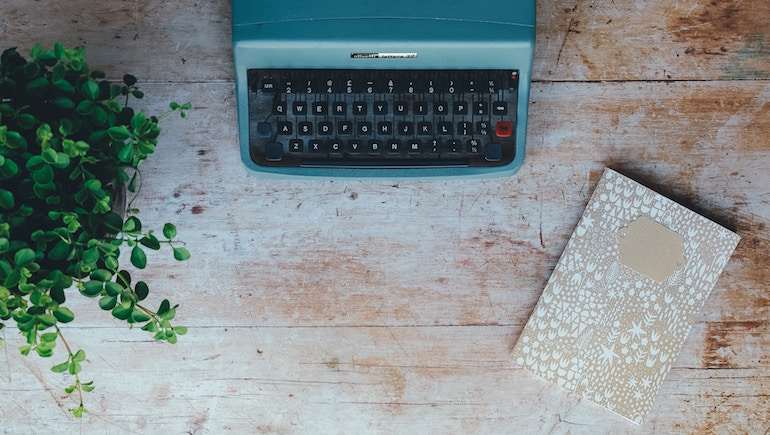Sign up for the Family Tree Newsletter Plus, you’ll receive our 10 Essential Genealogy Research Forms PDF as a special thank you!
Get Your Free Genealogy Forms
"*" indicates required fields
You know your family history is worth putting to paper. Every time you share it verbally, people listen intently as the story unfolds, detail by detail. Still, when you sit down to write, the perfect words evade you. You’re not even sure where to begin.
The most exciting part about writing your family history is that you get to choose what details you include. You might focus on one person and paint a very detailed portrait of them with just your words, from the moment they were born until the day they died. Or you might zero in on a specific event that shaped your family and weave in imagery specific to the time period.
Ultimately, you have many creative options! Still, you will want to decide on a specific form of writing that best suits the type of story you aim to tell.
ADVERTISEMENT
Why Write Your Family History?
First, however, it could help to understand why you might want to write your family history in the first place. There are many reasons, including:
You want to highlight a specific person. Maybe you have an ancestor who is a decorated soldier from a major conflict or a well-seasoned traveler who has traipsed across the globe. Maybe they are just an all-around fascinating person whose story you think is worth telling. Writing your family history allows you to introduce that person to an audience who has never met them—just through words alone.
You want to preserve timeless family memories. In some cases, you might not have just one ancestor you wish to highlight but many different memories created across several periods of time with multiple people. By writing your family history, you don’t have to rely on your own brain to conjure up those memories and relay them on demand. Instead, you can preserve them on the page and share them with whomever wishes to read them.
ADVERTISEMENT
You want to improve your skills as a writer. No matter what project you undertake, writing your family history requires a great deal of creativity. If you are writing a biography, you need to be able to pinpoint which details about your ancestor to showcase and which details to omit. If you choose a more personal form like a memoir, you need to be able to dissect a memory for its emotional rawness and describe the moments that best propel the narrative forward. Regardless of the final product, successfully completing these tasks are sure to deepen your sense of creativity and sharpen your facility with the written word.
With all that said, below we define some common family history writing forms and provide exercises that can get you started on your own project.
Historical Narrative
Your grandfather was a child during the Great Depression and has over the years shared harrowing details from that time. He has spoken reverently of his many siblings, the small but cozy home his family shared, and the scant but delicious meals his mother prepared every night.
If you want to tell the story of your grandfather in the context of the Great Depression, the historical narrative allows you to do just that. A historical narrative is a form of writing that details historical events using elements of storytelling. It can be told either first-hand by the person who experienced said events or by an outside party. Thus, through the historical narrative, you can bring your grandfather and his family to life for your readers while also educating them about the Great Depression.
Remember that a well-written historical narrative contains both active, engaging prose and careful research. Therefore, you should study thoroughly the time period about which you are writing, even beyond your ancestor’s personal stories. That way, you can ensure that you are doing their story justice by building the most accurate world around it.
Exercise: Pick a historical event. It can be one that a family member has experienced directly or even just one that you happen to know a lot about. Write a short paragraph (4-5 sentence) summarizing the event using just your current knowledge. Stick to the facts and don’t get too descriptive yet.
Next, write a descriptive paragraph about the event. What you focus on is up to you; it can be a particular person or the location at which the event took place. Include as many sensory details as you can, but rely on only your current knowledge of the event. Don’t Google anything just yet!
Finally, research your historical event online and pick an article on the topic (Wikipedia counts here!) Skim the text to get the gist of the event. Now, write one last descriptive paragraph that makes use of your new knowledge of the event. Note: Have you included any new descriptions? Have any of the descriptions in your previous paragraph changed?
Biography
A biography is a story of a someone’s life, told from the perspective of another person. It often includes key details about the subject—where they were born, where they attended school, when and whom they married, when and how they died and so on. In sum, while biographies may vary in their structure, they typically have a clear beginning, middle and end, often mirroring the natural order of a person’s life.
Effective biographies offer more than just lists of facts, important dates and brief descriptions of physical appearance. They explore who a person was an individual—in other words, not just where they were born but what their childhood was like, not just whom they married but how their relationship with their spouse unfolded.
The biography is an ideal form if you want to tell the life story of a specific ancestor and have lots of fun facts about them that you long to share, but have had no or limited interactions with them.
Exercise: Find a photo of an ancestor and write one paragraph describing them based only on what you see in the photo. Then, write one more paragraph. This time, add details beyond the photo and focus on a specific time in that person’s life. That time could be anything, so long as you know some key details about it—for example, a wedding, the birth of a child, even something less life altering, like a victory during a favorite childhood game.
As you write, ask yourself: Based on what you know about this person, what would they have been doing moments before the photo was taken? Moments after? How do you think they chose the outfit they are wearing?
Autobiography
Like a biography, an autobiography tells the story of a person’s life, but there is one twist: The story is told by the person in question. In other words, you tell your own life story, from the beginning up to now! In doing so, you will likely use the words like I, my, me and we a lot.
Unlike the biograph, in which you maintain some distance from your subject, the autobiography demands that you remain in the center of the action. Therefore, the autobiography is an ideal form if you want to tell your story about a yourself and a family member with whom you have spent most of your life. For example, if you were raised by your grandma from birth and want to share that experience, your autobiography will likely contain vivid details about shopping as Grandma pushed you in your stroller, doing your homework at the kitchen table while Grandma prepared dinner and walking down the aisle with Grandma at your side on your wedding day. Like a biography, your autobiography will ideally have a clear beginning, middle and end.
Exercise: Write your origin story! You will start by writing three paragraphs: One about your childhood, one about your teenage years and one about yourself in the present day. Include as many details as you can. Ask yourself: What did I like to do as a child? As a teen? How does that differ from what I enjoy doing now—or is it more or less the same? What did I look like as a child versus a teen versus an adult in the present?
After you have written your three paragraphs, think of a family member who has influenced you in some notable way. Write new paragraphs featuring child you, teen you, and adult you—but this time, incorporate memories featuring this person. Ask yourself: How did they shape you as a child, as a teen, as an adult? Did you even know them during all of these phases of your life?
Memoir
A memoir is similar to an autobiography in that it allows you to relay a personal story from the first-person perspective. There is, however, one important distinction: Whereas an autobiography focuses on a person’s entire life, a memoir tends to zero in on one specific point in time.
To expand upon the grandmother example above, you might choose to write a memoir if you wish to highlight a very specific time in your life, the role your grandmother played in it, and how that experience shaped your present identity. So if you wish write about how your grandma helped you get through school and accepted into the university of your dreams, you’ll probably include just the memory of Grandma helping you with your homework while also attending to a hot stove, as that detail contributes to the overall narrative thread. On the other hand, you may omit the memories involving shopping and walking down the aisle, as they are unrelated to your academic success with Grandma’s guidance.
Exercise: Take a moment to think of the following: a specific person and your earliest memory of them, your most pivotal memory with them, and your last memory with them. Then, starting with your earliest memory, write a paragraph in which you explain what happened. As you write, consider: was this the first time you had interacted with this person, to your knowledge? What did your surroundings look like? Did any specific objects jump out to you?
Next, write a paragraph describing your most pivotal moment with this person. As you write, consider: What makes this memory so pivotal, and what role did this person play in making it so significant? What lessons did you learn in that moment? Did you learn those lessons directly from the person in question or from your own self-reflection?
Finally, write a paragraph describing your last memory of the person. Where did it take place? How did you feel, and how did they feel? What was said, if anything?
Edited Letters and Journals
You are searching through your great grandma’s possessions when you stumble upon something incredible: a tattered journal whose pages have been covered in neat, wispy penmanship. You read each page carefully, laughing and crying as your great grandma tells stories about her first date, her first ride in your great grandpa’s pickup truck, their happy marriage and more. You even find love letters addressed to your great grandpa tucked between some of the pages! The journal and the accompanying letters are so engagingly written that you want to share it with someone.
Letters and journals written by your ancestors are special in that they tend to do the hardest part of the storytelling process for you: telling the actual story. Your job is to ensure that you present their words in a way that remains true to their voice and intentions. There are a few ways you can go about this. One option is to simply transcribe your ancestor’s text word-for-word. In this situation, you do not make any changes to the actual writing.
Of course, in some cases, the writings may not make complete sense without context. This is where annotations can come in handy. Annotations are not corrections to your ancestor’s writings; rather, they are blurbs of text that provide context, define potentially unfamiliar terms and words and add depth or clarity to the events or people described in the letters.
Exercise: Take an entry from an ancestor’s diary or a letter written by an ancestor and identify at least 5 words, phrases or entire passages that may be unclear to the average reader. Write short annotations (2-3 sentences) for each of the items you selected. Ask yourself: Why did you select these items? How do your annotations clarify what your ancestor had written?
Genealogical Fiction
Sometimes, readers just want to escape into a world different from our own, albeit with some familiar people and places. Likewise, writers often want to blur the lines between truth and imagination while still writing what they know better than anything else: their own families. The result? Genealogical fiction!
While it may borrow many elements from a real person’s life, genealogical fiction is driven not by objective facts but by riveting plot. Similarly, writers may base their characters off ancestors or other people they know; they may even give them the same names. However, the reader can assume that the story for the most part has been fictionalized for literary effect.
Genealogical fiction is the perfect genre for writers who want to honor their ancestors with excellent prose that brings their memories to life without revealing too many personal details. The genre also allows for more creativity and “truth bending.” Within reason, characters don’t have to follow some chronological timeline based on what really happened. You get to build your own world and create a story around it.
Exercise: Think of a family member. Write a paragraph in which you describe them as precisely as possible. Imagine what they look like, what their personality is like, what they do for a living—any specific details that make them them. Next, imagine a tangible object. It can be anything—something mundane like an apple or pencil or something more eccentric like a kaleidoscope or clown figurine. The only rule is that the object must be something you can see and touch. Now, write a paragraph or two in which your family member interacts with said object. Get creative. Transport them into a new world. Ask yourself: how would this object make them feel? What problems could this object solve? Could this object create any problems?
Genealogical Poetry
Maybe you don’t have a linear story about your ancestors you wish to tell. Instead, you have a collection of vivid memories all tied together by a central theme and a whole lot of emotion. In this case, you might consider writing a collection of poems. Poetry can take many different forms. You might write sonnets, a form of poetry that both rhymes and follows a strict structure. Contrarily, you might opt for a form of poetry that allows for more freedom, like a free verse poem or a prose poem. You could even write a combination of different poems. Whatever form you choose, poetry allows you to play with language and memory in ways that other genres may not allow.
Exercise: Find an object that a family member had given to you. It can be anything: a quilt you had since you were baby, a stunning wedding dress, even a delicious recipe for carrot cake. Now write a poem in which you describe that object and how you came into possession of it. Ask yourself: How can you bring this object to life for readers who have never seen it? What does it look like, feel like, smell like? What emotions does it evoke?
Related Reads
ADVERTISEMENT









